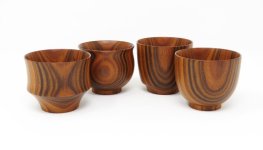Mike Stafford
Member
- Messages
- 2,353
- Location
- Coastal plain of North Carolina
I am trying to rid myself of odd sized pieces of wood. I bought some of these sticks when I was making handles for lathe chisels. They have languished in the wood pile long enough and need to turned and displayed.
These four Japanese-style cups are turned from Santos rosewood. They are all about 2 1/2" tall and 2 3/4" in diameter. This fine-grained wood possesses great strength and you can turn really thin without much fear of damage. These cups are 1/16" thick. I love turning hard dense woods.
By the way, this timber is marketed as Pau Ferro, Morado and Bolivian Rosewood in addition to Santos Rosewood. In truth it is not in the rosewood family at all which is the Dalbergia spp. This wood is in the Machaerium family. This wood has many warnings about allergic reactions. I have not (knock on wood) been affected by it to date and over the years I have turned a lot of it. My recommendation is that if you are turning an exotic for the first time make sure someone is around in case you do have a reaction.

These four Japanese-style cups are turned from Santos rosewood. They are all about 2 1/2" tall and 2 3/4" in diameter. This fine-grained wood possesses great strength and you can turn really thin without much fear of damage. These cups are 1/16" thick. I love turning hard dense woods.
By the way, this timber is marketed as Pau Ferro, Morado and Bolivian Rosewood in addition to Santos Rosewood. In truth it is not in the rosewood family at all which is the Dalbergia spp. This wood is in the Machaerium family. This wood has many warnings about allergic reactions. I have not (knock on wood) been affected by it to date and over the years I have turned a lot of it. My recommendation is that if you are turning an exotic for the first time make sure someone is around in case you do have a reaction.





